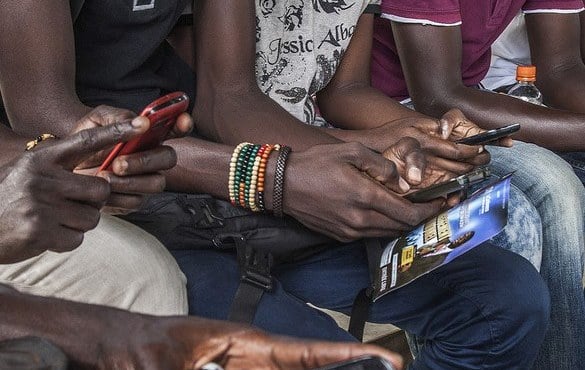Will biometric authentication be the norm by 2020? What’s the forecast value of the digital revolution for India? What’s the latest data on Android versus IOS numbers globally?
You’ll find the answers to these and many more mobile data related questions in this week’s MEF market stats round up…

$5.6 trillion of payments will be secured by biometric technology in 2020
Goodbye and good riddance passwords, the age of biometric authentication is nigh. So says Goode Intelligence in a new report that predicts over $5.6 trillion of payments will be secured by biometric technology by 2020.
More than 50 million customers will make biometrics secured payment transactions during 2015. This number will rise to 226 billion in five years’ time. Goode believes at least eight biometric technologies will be used in different payment scenarios: behavioural, eye (iris and eye-vein), face, fingerprint, finger-vein, heart rate, palm-vein, and voice.
The study, Biometrics for Payments – Payments Security Gets Personal, also tracks developments in physical retail store/point-of-sale (POS) terminal integration, eCommerce (web-based payments), mobile payments, wearable payments, bitcoin, and ATM (cash and bitcoin).
Read more…
Digital ‘revolution’ will give a $330bn billion boost to India
The Indian technology and services market could deliver $225 billion in revenues by 2020 – and $350 billion by 2025, says a Nasscom-McKinsey report.
Perspective 2025: Shaping the Digital Revolution says the adoption of digital technologies is transforming the Indian economy. It says digital technology will rise from 10 per cent of total investment in 2014 to 35 per cent in 2020 and 60 per cent in 2025.
Companies hoping to prosper in the new environment will have to embrace six new service lines: the Internet of Things, cyber security, social, mobility, analytics and cloud.
Read more…
Global in-app advertising set to grow 40 per cent a year
A new report by Technavio predicts stellar go-going growth for in-app advertising. It reckons the huge popularity of social networks is giving app marketers an excellent platform to promote their apps – and that this is fuelling a boom in advertising.
Technavio says in-app advertising will grow at a CAGR of almost 40 per cent from 2015 to 2019.
While app install ads on Facebook and LinkedIn offer one route to growth, the other is the overall rise in mobile connectivity. The report says, in 2014, 42 per cent of the world population used the Internet.
Read more…
Mobile added $102bn to Sub Saharan African economy in 2014
How important is mobile to Africa’s economic development? Pretty much critical, according to a report released by GSMA. The global trade body says the mobile industry contributed $102 billion to Sub Saharan Africa’s economy in 2014 – that’s 5.7 per cent of the region’s gross domestic product. And it predicts the industry will contribute $166 billion in value to the region by 2020, equivalent to eight per cent per cent of expected GDP by this point.
The study, The Mobile Economy – Sub-Saharan Africa 2015, estimates that mobile operators directly contributed $31 billion last year. It asserts that this figure will increase as operators take mobile broadband to unconnected populations. GSMA says they invested $9 billion in network infrastructure in 2014. The report notes that there will be 386 million unique mobile subscribers in Sub-Saharan Africa by the end of this year, equivalent to 41 per cent of the region’s population. Total mobile connections will reach 722 million. The region grew at more than twice the global average (6 per cent) during this period.
Read more…
Android loses share to iOS in Europe; other way round in the US
The global smartphone market is as hard to call as ever, according to new stats from Kantar WorldPanel ComTech to August. Kantar shows that Apple grew its share in EU5 by 2.4 per cent to 16.2 per cent, while Android slipped by 3.3 per cent to 72.2 per cent. But then, in the US, iOS fell by by 2.1 per cent to 28.4 per cent, while Android rose by 2.5 per cent to 66.9 per cent. Mind you, these figures were for the three months ending August 31, before the release of the iPhone 6S and iPhone 6S Plus. Given the record-breaking early sales of these devices, one can expect to see a boost for iOS in the next quarterly update.
Carolina Milanesi, chief of research at Kantar Worldpanel ComTech, says: “11 per cent of iOS owners told us in August that they plan to replace their current phone in the next three months, and 87 per cent of these have told us that Apple is their preferred brand.”
The report also noted a hiccup for Samsung, after the firm’s Galaxy S6 struggled to match the success of its predecessors. It said Sony and LG were the only two Android smartphone vendors to see growth during the three-month period.
Read more…
Half of all online purchases involve multiple devices
When it comes to buying stuff from the internet, cross-device is the new normal. That’s the conclusion of the latest consumer research by Criteo.
The ad giant’s State of Mobile Commerce Report Q3 2015 study found that four in 10 purchases in the US, and 50 per cent worldwide, now involve multiple devices throughout the consumer buying journey.
For purchases completed on laptops and desktops, 39 per cent of buyers use at least one additional device during the shopping process. On mobile, 43 per cent of smartphone buyers and 47 per cent of tablet buyers use an additional device.
Criteo reckons the brand that do best prioritise apps over mobile sites. It reveals that for retailers who do this, 58 per cent of mobile revenue is generated through the app.
It also reports that mobile commerce now represents 35 per cent of all e-commerce transactions globally.










